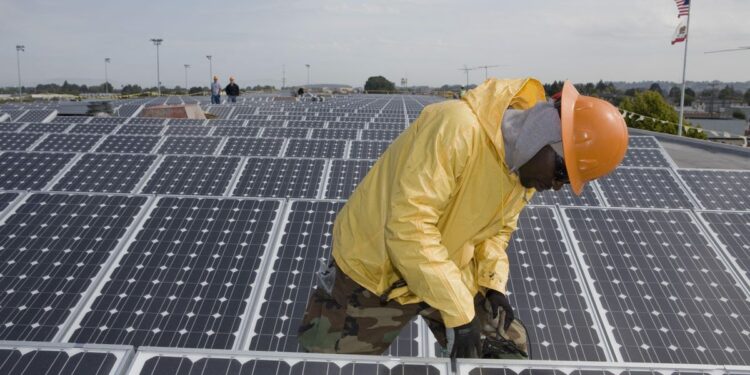The nation may meet President Biden’s interim targets to cut CO2 levels. But the goal of getting to net zero by 2050 is a more formidable challenge. That’s what the Electric Power Research Institute (EPRI) says, noting that the electrification of the entire economy will play a crucial role.
Obstacles abound — mainly because the technologies to achieve net-zero have not yet reached scale. Getting the rest of the way will require a proactive government to stimulate investment in such things as clean hydrogen, battery storage, and a more robust network. If the grid is smarter, it could transport more green electrons and avoid blackouts during peak usage.
“There has to be coordination and collaboration across federal and state governments” — to solve innovation, regulation, and market issues, says Daniel Brooks, vice president of integrated grid and energy systems at EPRI, during a press conference last week on the state of the electric sector. Industry and skilled labor have to get on board. A key barrier: “The changing climate and the impact that this can have on electricity supply and customer needs.”
The Biden administration’s goal is to reduce CO2 levels by 50% by 2030 and to hit net-zero by 2050. That will create $23 trillion economy. Among the utilities committed to net-zero targets: Alliant
LNT
, Ameren
AEE
, American Electric Power
AEP
, CenterPoint Energ
CNP
y, ConEdison, Dominion Energy, Duke Energy
DUK
, National Grid, and Southern Company
SCCO
.
Renewable energy will be a significant benefactor, which has already jumped by 250,000 megawatts over the last decade and could supply 33% to 50% of electric generation by 2030. That means expanding onsite generation and advanced energy storage. It also means producing far more green hydrogen from wind and solar power. And it means investing in next-generation nuclear energy, which already comprises 55% of this country’s carbon-free power.
Electricity now makes up 20% of all end-use energy consumption in this country. By 2050, however, that could rise to 60%, EPRI says. EPRI’s Chief Executive Arshad Mansoor points to the transport sector and says there will be 150 new electric vehicle models by 2030. BloombergNEF says that 28% of all new cars will be EVs by 2030 and they will be 58% by 2040.
Beyond being environmentally beneficial, Mansoor says that this would be financially helpful to households. They could cut their energy bills by 10% because they would avoid buying gasoline.
Smarter Grids
But the grid has to be able to handle the increased traffic and the influx of intermittent energy sources that depend on the weather. What investments will ensure reliability and resiliency? California, for example, plans to get to 60% renewables by 2030 and to 100% by 2045. The state’s independent system operator has called distributed energy resources “absolutely critical” — a way to alleviate strain on the primary grid while using clean energy and ensuring reliability.
Indeed, using solar rooftop generation combined with battery storage and microgrids is becoming more commonplace. While those assets can operate independently of the primary grid, they can also be used as backup power — to kick on when the power turns off. Consumers could also choose to send that electricity back to their utility and earn money. Utilities benefit as well by avoiding wear-and-tear on their grids.
“We understand their variability,” Elliot Mainzer, chief executive of the California ISO, told this writer during an earlier panel, referring to wind and solar energy. The ISO is the state’s grid operator that orders up electricity supplies and then directs those electrons to where they need to be. “We are good at planning and procurement, and you can get ahead of that curve.”
The United States has reduced its annual energy-related CO2 release by about 1 billion tons since 2005. But EPRI says that the U.S. must do double-time over the next 15 years to reach its mid-century goals. That requires innovation. It says the focus must therefore be on energy efficiency, decarbonized electricity, and electrification in transportation, buildings, and industry.
Critical Link
For example, roughly 70 million tons of hydrogen a year is used worldwide. But 98% of hydrogen production comes from using carbon-intensive sources. The aim is to produce hydrogen from low-carbon energy sources — “green hydrogen” — and expand its use into the transportation and power generation sectors. The International Renewable Energy Association (IRENA) estimates that hydrogen could make up 12% of global energy use by 2050.
The association predicts that the mid-2030s will be the turning point — the time when green hydrogen will be competitive with “grey hydrogen” produced from fossil fuels. It may happen even earlier in China, Brazil, and India. And when natural gas prices skyrocket, it is immediately competitive.
“Hydrogen could prove to be a missing link to a climate-safe energy future,” says Francesco La Camera, director- general of IRENA. “Hydrogen is clearly riding on the renewable energy revolution with green hydrogen emerging as a game-changer for achieving climate neutrality without compromising industrial growth and social development.”
EPRI says there is no “silver bullet” to solving the climate crisis. The technologies to reach the president’s 2030 goals now exist, meaning those short-term goals are within reach. But to hit net-zero by 2050 is a longer stretch— one that depends on ideas currently in the labs or still on the drawing boards. Bringing them to market will require a financial commitment and a headlong march into the green tech economy.











